II. Seeing the Forest for the Trees: Placing Washington's Forests in Historical Context
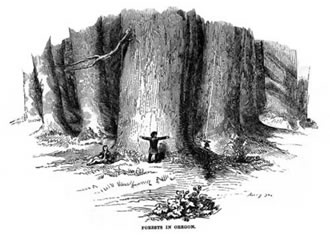
Washington's forests have always been a prominent element of its history. Until the past 120 years, tall and dense stands of Douglas fir, hemlock, spruce, and cedar blanketed most of the area from the crest of the Cascade Range to the water's edge. Ponderosa pines were prevalent in areas east of the summit of the Cascades. The presence of these trees has shaped Washington's economic development for decades. The forests have helped define the identities of many Washingtonians and have served as a symbol for the Evergreen State. Nonetheless, the long history of Washington's forests demonstrates that there has never been a simple, singular vision for this resource. Attitudes toward and uses of the trees have changed dramatically over time. Washington's forests have been—and continue to be—contested and coveted by many competing groups and individuals.
The history of Washington's forests can be divided into four broad periods. Until 1848 the vast forests sustained several Indian tribes and fascinated Anglo explorers. During this first period the lumber industry was still in its infancy, with the Hudson Bay Company erecting the first mill in the Pacific Northwest at Fort Vancouver in 1828. The beginning of the California Gold Rush in 1848 brought the second phase. At this time several outside investors, most from San Francisco, built mills along Puget Sound, propelling the lumber industry into the dominant role in the area's economy
The third era, from 1883 to 1940, produced technological developments and large capital investments, which allowed lumber companies to intensively log areas they could not reach before. The expansion of the railroad to the Northwest fueled this process. This period of time was also characterized by the increasing involvement of government and labor in the lumber industry. Government implemented many reforms to ensure that the supply of trees would not be depleted in the future, and it preserved some forested areas from further development. Labor unions also became active, demanding higher wages and better working conditions. The last phase, from 1940 until the present, brought a decline in the lumber industry's relative importance to Washington's economy. Even as timber harvests reached record levels during and after the Second World War, the industry lost its position as the state's largest employer. The postwar years also witnessed the growing power of the environmental movement, which sought to keep loggers out of large sections of Washington's forests.
A. Washington's Forests before 1848
Although Indian peoples did not harvest trees at the rapid rate of later lumbermen, they did actively manage the forests. Many Indian groups along the Puget Sound and the Pacific Coast used wood for harpoons, baskets, and mats. The red cedar was particularly important for the construction of homes and canoes. James Swan, a visitor to the Northwest in the mid-19th century, described, in intricate detail, the labor involved in canoe construction (see document 3). In addition, Indians set annual forest fires in order to encourage the growth of certain food crops. For instance, the Salish who inhabited Whidbey and Camano Islands burned the forest underbrush to increase the supply of berries and camas. Setting fires also improved hunting opportunities by maintaining and augmenting the amount of open land used by game animals. Out of the forests, the Salish and other Northwest Indian peoples actively created an environment that sustained their communities.
Many white explorers made special note of the vast stands of trees in the Pacific Northwest. The extent of the forests and the height of the trees amazed them. Aboard the Discovery, British explorer George Vancouver traveled along the southern shore of the Strait of Juan de Fuca in 1792 and described the landscape as "luxurious." "The whole had the appearance of a continued forest extending as far north as the eye could reach," he wrote, "which made me very solicitous to find a port in the vicinity of a country presenting so delightful a prospect of fertility." Vancouver described other parts of the Puget Sound region as "inpenetrable wilderness of lofty trees, rendered nearly impassable by the underwood, which uniformly incumbers the surface." As Commander of the United States Exploring Expedition of 1838-1842, Charles Wilkes visited the Northwest and made similar observations (see document 2). As he traveled through a "gigantic fine cedar forest" near the Nisqually River, he encountered trees that "although they are sapplings, were 6 feet in diameter and upwards of 200 feet in height." He stated, "I could not control my astonishment" at the size of the trees.
Such accounts attracted white entrepreneurs and settlers bent on using the forests for profit. The Hudson's Bay Company (HBC) was the first significant developer of the region's timber resources. In 1825 George Simpson, governor of the HBC's operations in North America, transferred the company's regional headquarters to Fort Vancouver, 80 miles above the mouth of the Columbia River. Because HBC ventures focused on the fur trade, Simpson found that ships and men were idle during the off-season. To utilize the company's resources year-round, he initiated the construction of a lumber mill at Fort Vancouver and expanded the firm's activities to the lumber trade in 1828. The HBC shipped much of its lumber to Hawaii, where missionaries and merchants needed building material. In little time, lumber gained a prominent place in HBC operations. However, after Great Britain gave up its rights to the mainland south of the 49th parallel in 1846, the company eventually sold its forts in the lands that became the Oregon and Washington Territories of the United States. Americans began to develop Washington's lumber industry where the HBC left off.
B. The Rise of the Lumber Industry, 1848-1883
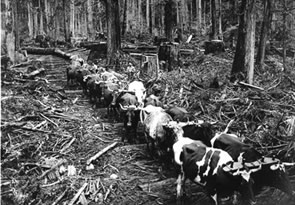
Beginning in 1848, the California Gold Rush created a huge surge in lumber production on Puget Sound, which boasted great stands of timber and deep, safe anchorages. Puget Sound sawmills provided San Francisco and other boomtowns with much-needed building material. By the mid-1850s, there were over two dozen mills in Puget Sound, many built by San Francisco investors, such as Andrew Jackson Pope, F. C. Talbot, William Renton, and Asa Mead Simpson. Many of these investors had roots in older lumbering regions, such as Maine. Pope and Talbot built the Puget Mill Company at Port Gamble in 1853. William Renton opened a mill at Port Blakely the same year. Many smaller mills opened along the shores of Puget Sound and Grays Harbor in the years that followed. By 1860 the Northwest lumber industry was centered in western Washington. Although there were many logging operations, their impact was initially limited: until the 1880s the cost of transporting logs over land confined logging to areas within a mile or two of the water's edge.
To keep their Puget Sound mills running efficiently, lumber companies often established mill towns, where they were virtually free from the interference of the government, competitors, and labor organizers. Caroline Leighton, a writer who traveled around the Pacific Coast from 1865 to 1881, described the conditions in Washington Territory's mill towns as "feudal" because "these great mill-owners have such authority in the settlements." However, lumber firms concerned about the stability of their workforce tried to provide reasonable accommodations for their workers. The typical mill town consisted of a sawmill on the waterfront, a company store, a manager's house, cottages for married workers, and a hotel for single employees and visitors. Most mill towns also had a school, a church, a saloon or two, and a baseball field. Millworkers received reasonably high wages and agreeable food (see document 11). Although the mill owners provided for basic needs, the workers' lives were extremely isolated. The towns were mostly male worlds with little entertainment and limited contact with other communities. Not surprisingly, gambling, drinking, and fighting were common pastimes in mill towns.
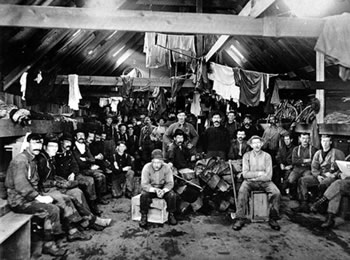
Other workers lived in transitory and fairly primitive logging camps. After a timber cruiser surveyed an area and found a good logging location, the boss logger—the manager or owner—obtained a title to cut the trees and moved to the locale with his crew. They set up a camp, consisting of rudimentary bunkhouses and mess halls. There was often a main building split into two rooms, one for sleeping and one for cooking. To keep warm and eliminate the dank conditions, there was a round iron stove in the center of the bunkhouse. The camps were temporary and portable; when the timber was cut in one area, the camps relocated to new forests. These places also lacked any semblance of family life, as almost all the workers were single men who migrated from camp to camp. (Document 34 and document 35 are photographs of lumber camps.)
Whether they lived in established mill towns or transitory logging camps, lumber workers performed demanding and dangerous work. Fallers, working in pairs, cut the trees by hand using axes and crosscut saws (see document 9). They had to use great care to make the trees fall in the proper direction in order to prevent breakage and to place the timber in the best position to be hauled. After the trees had been felled, buckers stripped the bark from the logs and sawed them into suitable lengths. Another set of workers then placed the logs onto oiled skids—small planks or logs—and hauled them to the main skid road, where bull teams of oxen would yard—drag—the logs to the mill or to a landing on a river or the Puget Sound (see document 13 and document 14). If the logs arrived at a water landing, boom men sorted the logs and formed them into rafts, which ships towed to the mills (see document 38). Millworkers took the logs out of the water, sawed them at the steam-powered mills, and loaded them aboard vessels bound for California, Hawaii, Australia, or other destinations along the Pacific. Loading lumber was a time-consuming process, often performed by Native American laborers. The lumber industry often used an ethnic and racial hierarchy to allocate various tasks. Falling and millwork paid the best, and these jobs were generally reserved for whites born in North America or northern Europe.
The lumber industry sustained many Washington Territory residents, but other Anglo settlers grew resentful of the dominance of the San Francisco-based timber firms because they wanted Washington to be a self-sufficient commonwealth of farmers. The forests, however, served as a decisive obstacle to their homesteading dreams. To make room for farms, settlers had to log the dense forests. Cut-over areas were sold as farmland, although many so-called stump farmers eventually gave up after trying to grow crops with little success. Settlers learned quickly that Washington's heavily forested areas could not be converted into an agrarian paradise of small, prosperous farmsteads.
Because it was clear that Washington's forests would not easily give way to bountiful farmlands, some boosters emphasized that the territory's future would be sustained by its "inexhaustible" supply of timber. Asa Mercer—who settled in Seattle, became president of the territorial university, and served in the upper house of the territorial legislature—published a promotional guide to Washington Territory in 1865. He appealed to prospective emigrants by touting the region's burgeoning lumber industry and the expanding markets for timber. "Here is now a great trade in lumber," he remarked, "and every year will see it increase" (see document 5). Similarly, Ezra Meeker, another early settler in Washington Territory, described the region's infinite timber resources, noting, "We need have no fear that [the supply] will ever be exhausted" (see document 6).
As the lumber industry expanded, political and economic conditions encouraged fraudulent land practices. Federal regulations prohibited the removal of timber from public lands, but many mills ignored such mandates, particularly since government agents were scarce. In the late 1850s the federal government sent U.S. Attorney John Jay McGilvra to Washington Territory to combat the illegal cutting. After realizing that he could not stop the logging of public lands, McGilvra created a system to regulate the process: mill companies pled guilty to the theft of public timber and were charged a modest fine of 15 cents per 1,000 board feet they cut. The government again tried to end corruption by passing the Timber and Stone Act of 1878. This legislation allowed residents of Washington, Oregon, California, and Nevada to acquire 160 acres of timber or mineral land at $2.50 per acre. Corporations could not file such timber claims because the law was designed to help farmers, but enforcement was inefficient, and lumber companies used the law to amass substantial landholdings. In the words of the historian Richard White, the Timber and Stone Act "had loopholes so large that entire crews of sailing ships walked through them and filed on timber claims that they immediately sold to the mill companies."
Out of self-interest, the Northern Pacific Railroad took matters into its own hands and launched a campaign against illegal logging on the public domain. In 1864 the federal government had agreed to subsidize the construction of the railroad. It received a twenty-mile-wide strip of land on alternate sections (in a checkerboard pattern) for each mile of track laid in the states and a 40-mile strip for every mile of track in the territories. The Northern Pacific tried to locate its track through heavily timbered areas to maximize the value of its land grant. Because it stood to acquire so much valuable federal land, the railroad worried about timber theft. With the help of the attorney Hazard Stevens, the son of Washington Territory's first governor, the Northern Pacific convinced the government to strengthen its efforts to catch timber poachers in the 1870s. Although illegal cutting did decline, the continued prevalence of corruption was demonstrated by the fact that the railroad later fired Hazard Stevens after he was accused of taking bribes and allowing mill companies to log government and railroad land.
C. Technology, the Railroads, and Capital, 1883-1940
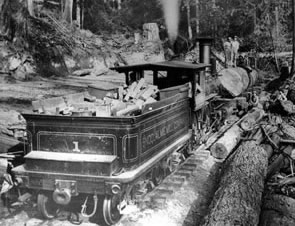
In the 1880s the railroads gained even more power in the lumber industry. When the Northern Pacific completed its transcontinental line in 1883, it owned 7.7 million acres in Washington Territory, a figure that constituted 18 percent of Washington's land area. The railroad initially reached its Tacoma terminus by way of Portland, but in 1887 it opened a direct route across the Cascade Mountains to Tacoma, providing efficient transportation to Puget Sound mills. The Great Northern Railroad quickly followed suit, finishing its line to Seattle in 1893. The arrival of the railroads was a significant development, allowing Puget Sound firms to sell lumber in eastern markets. The railroads also brought new settlers to the Pacific Northwest, which stimulated a building boom that depended on more lumber. Moreover, traditional lumbering centers around Puget Sound, such as Port Gamble and Port Blakely, lost some of their influence. New timber centers developed around Tacoma and Grays Harbor, and the new mills used the railroads to ship lumber to an expanded national market.
During the 1880s the lumber industry was also transformed by major technological developments, particularly the donkey engine, patented in 1881. As forests right next to the water became relatively scarce and logging moved inland, it became apparent that bull-team logging had to be replaced by a more efficient method. Consisting of a small steam engine set on skids and attached to a winch, the donkey engine pulled logs from the woods with cables (see document 15). It moved logs much faster and for longer distances than did oxen and horses. Thus, the donkey engine enabled companies to halve the cost of log removal. Sometime after 1905 loggers developed a new way to use donkey engines. Instead of yarding logs across the ground, workers could use donkey engines to haul logs through the air by suspending cables and pulleys from the top of a tall tree called a spar tree. This technique was called high-lead logging (see document 18 and document 19). It made yarding even more efficient and allowed firms to cut trees on steep slopes and in narrow valleys. However, the process of moving huge logs through the air above workers' heads also increased the number of industrial accidents.
The development of narrow-gauge logging railroads was another important innovation. Though the donkey engine enabled loggers to haul logs considerable distances, there was no efficient way to move logs from the deep woods. Many mill owners wanted to harvest this timber in order to increase the timber supply and counteract rising prices. In the 1880s a few mills began to build logging railroads, opening up new stands of timber that were previously inaccessible because of the rugged terrain and the distance from the water (see document 16). Both the donkey engine and the logging railroads made mechanical power indispensable to the lumber industry. New technology, however, also ensured the dominance of large logging companies because small operations could not afford the new equipment (see document 17).
New technologies and railroad expansion reached the Pacific Northwest as lumber companies depleted the Great Lakes timber supply. The timber giants of the upper Midwest looked to expand their operations westward, as indicated by the establishment of the St. Paul & Tacoma Lumber Company in 1888. Chauncey Griggs, a Minnesota grocer, and several associates created this mill through the purchase of 80,000 acres of timber from the Northern Pacific Railroad. It was the first mill to deliver its timber entirely by rail. Still shipping lumber by sea, the old San Francisco-based mills, such as Pope & Talbot's Puget Mill Company, hoped that the new mills would be too busy with the eastern market to attempt to break into their traditional markets in California and other Pacific locales (see document 12).
Frederick Weyerhaeuser, another Minnesota investor, gave the Washington lumber industry a huge boost with his arrival in 1900. He bought 900,000 acres of western Washington timber from the Northern Pacific Railroad to become the second largest private holder of timber in the nation. After an additional transfer from the Northern Pacific in 1903 and several smaller purchases from other owners, Weyerhaeuser's holdings encompassed 1.3 million acres (which was 26 percent of all private timberlands in Washington). Initially, the Weyerhaeuser Company's main purpose was to acquire land and sell its timber to other firms. In the 1910s, however, the company began to take an interest in milling and manufacturing. It built mills in Everett, Snoqualmie Falls, Longview, Enumclaw, Aberdeen, and Raymond. Weyerhaeuser also experimented with pulp and paper production.
Technological developments, railroad expansion, and the arrival of large corporations transformed Washington's lumber industry, making it the dominant player in the state's economy. In 1879 the state's lumber production was 160 million board feet; by 1890 production had skyrocketed to over one billion board feet. In 1919 Washington produced 4.9 billion board feet of lumber. The timber industry became Washington's largest employer: a 1910 study by the U.S. Bureau of Corporations found that 63 percent of the state's wageworkers directly or indirectly depended on it for jobs. In 1905 Washington became the nation's leading producer of timber, a position it held until the late 1930s, when it was surpassed by its neighbor to the south, Oregon.
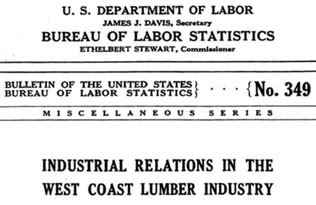
D. Government and Unions Enter the Woods, 1883-1940
The rapid expansion of Washington's lumber industry led many people to fear that timber companies would deplete the supply of wood. During the era of bull-team logging, Asa Mercer, Ezra Meeker, and others had claimed that Washington's timber resources were inexhaustible, but new technologies and dramatically increased logging made these statements seem hopelessly naive. The federal government stepped in and implemented measures to conserve the nation's forest resources. Passed in 1891, the Forest Reserves Act authorized the president to establish forest reserves on public lands. One of the primary purposes of the forest reserves was to protect western watersheds; farmers feared that logging, forest fires, and overgrazing would destroy the forests that regulated the flow of rivers. Furthermore, the federal government hoped that the forest reserves would guarantee a steady supply of timber for future decades. President Grover Cleveland set aside millions of acres of reserves across the West in 1897, including a 1.5 million-acre forest reserve on the Olympic Peninsula.
Over the next decade the federal government expanded the forest reserves and created a system to manage these lands. The Forest Management Act of 1897 gave the Secretary of the Interior the power to regulate the uses of the reserves, including grazing, irrigation, and lumbering. In 1905 Congress transferred control of the forest reserves (which were later called national forests) to the Bureau of Forestry (which soon changed its name to the Forest Service). The first head of the Forest Service, Gifford Pinchot, became a major leader in the Progressive Era conservation movement and played a key role in shaping the management of national resources in the U.S. He derived much of his power from the fact that he was a close friend and advisor to President Theodore Roosevelt. Pinchot, who was the first American to receive an advanced degree in forestry, promoted a philosophy of conservation that advocated the scientific and efficient use of natural resources for the common good. He believed that if the Forest Service set proper harvest levels and required proper logging methods, the national forests would provide a continual source of lumber for the American people.
Many Western interest groups feared the growing power of Pinchot and the Forest Service. Even though Pinchot promised to expand logging and grazing on the national forests, many Western ranching and logging companies feared that the Forest Service's conservationist policies would eventually restrict their access to natural resources. In 1907 Western Congressional representatives passed an amendment declaring that the President could not add lands to the national forest system in six Western states, including Washington state, without the consent of Congress. President Roosevelt strongly opposed the amendment, but he had to sign it into law because it was attached to a key part of the federal budget. However, Roosevelt and Pinchot figured out a plan to circumvent the amendment: on the eve of signing the amendment, they drafted an executive order that added millions of acres to the national forests. This executive order also created the Colville National Forest in northeastern Washington. Over the course of his administration, Roosevelt more than doubled the size of the national forest system in the Pacific Northwest. When he left office in 1909, almost 11 million acres of Washington state (25 percent of its total land area) was under Forest Service control. It was clear that the Forest Service would play a central role in shaping the future of Washington's forests and its logging industry.
Although many Western interests despised Pinchot, he was quite successful at gaining the support of lumber companies. He recognized that lumber firms were hesitant to replant trees after logging and implement other conservation measures because of taxation and the threat of forest fires. Owners had to pay substantial property taxes every year on the forestlands they had not yet logged. Because they also faced the constant possibility that a fire would destroy their timber, they had an economic incentive to cut their lands as rapidly as possible. To address this dilemma, Pinchot advocated cooperation between federal, state, and local governments and private landholders to reduce forest fire destruction, and he also called for tax policy reform. At the same time, many lumber executives also began to implement their own conservation measures. They supported the establishment of the University of Washington's forestry school in 1907 and created the Washington Forest Fire Association in 1908 and the Western Forestry and Conservation Association in 1909. Lumbermen were willing to develop conservation practices that complemented their economic interests, especially the need to prevent, detect, and fight forest fires.
Lumber executives also supported Pinchot because his ideas about forestry were fairly similar to their own. Like Weyerhauser and other corporations, Pinchot wanted to maximize the long-term output of lumber. According to his autobiography, he viewed "virgin forests" (which we would now call old-growth or ancient forests) as "inherently wasteful." Because many of their trees were dead and most of the rest were hundreds of years old, the volume of wood in these forests increased very slowly, if at all. In addition, the old-growth forests of the Northwest contained many alders, hemlocks, and other species that were not valuable for lumber. Pinchot wanted to cut down these "wasteful" forests and replace them with managed forests that would produce lumber quickly. The ideal forest would be composed only of high-value trees like Douglas firs. Once these trees reached maturity and their growth slowed, they would be cut down and replaced by a new managed forest. As long as one did not cut more wood than the forest was producing, this system would produce sustained yields of lumber forever. Even after Pinchot left the Forest Service in 1910, the idea of sustained-yield forestry remained enshrined as the agency's guiding principle. The notion of using the national forests to produce lots of lumber suited logging companies just fine.
While the Forest Service and lumber companies worked on conservation measures to ensure sustained yields, other parties became interested in the preservation of the forests from any future development. Unlike Pinchot and other conservationists, who believed in the practical use of natural resources, preservationists advocated the permanent protection of large tracts of public land, where logging, grazing, and dambuilding would be forbidden. Through the creation of national parks, they hoped to preserve the nation's scenic landscapes. Their successful national park campaigns included the creation of Mount Rainier National Park in 1899. However, the park's boundaries excluded the adjacent lowland, forested areas, which preservationist John Muir thought were equally worthy of protection. President Theodore Roosevelt subsequently set aside 615,000 acres from the Olympic National Forest to create Mount Olympus National Monument in 1909. But again, this was only a partial victory for preservationists. Unlike national parks, where logging was essentially prohibited, national monuments were administered by the Forest Service, which often allowed some grazing and lumbering there. Preservationists faced an uphill battle to protect forests because of their economic value.
Preservationists and conservationists were not the only groups to respond to the rapid expansion of logging in the Northwest. The growth of the lumber industry and its labor force sparked the formation of unions that fought for better wages and working conditions for white workers. In the 1880s the Knights of Labor, a national labor organization, worked to expel the Chinese from the West Coast lumber industry. The Knights were motivated by racial prejudice and a fear that the employment of Chinese loggers, who worked for low wages, precluded improved working conditions for whites. Facing pressure from the Knights, the Tacoma Mill Company and Port Blakely Mill fired their Chinese employees in 1885. In 1886 the Knights also launched a campaign to reduce the workday from twelve to ten hours. Strikers disrupted operations at several mills, and many mill owners adopted the ten-hour workday.
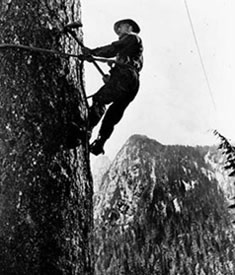
The ten-hour workday, however, did not address the high accident and fatality rates for those who worked in the lumber industry. Andrew Mason Prouty's study, More Deadly than War! Pacific Coast Logging, 1827-1981, documented the incredibly dangerous nature of the work. Prouty found that during the early 20th century, 1 in 150 loggers in Washington died every year. This fatality rate meant that one-third of all 18-year-old loggers would not live to become 65-year-old loggers. In addition, every year almost one in five loggers (and one in eight millworkers) suffered some sort of injury on the job. Some injured workers sued their employers for damages, and juries sometimes gave them generous awards. In most states, appellate courts limited employers' liability and routinely overturned verdicts in favor of wounded workers. However, Washington voters had elected several liberal governors who appointed pro-labor judges to the Washington State Supreme Court. This court often sided with injured workers, leading Washington lumber executives to complain that they had become easy targets for lawsuits. To protect themselves from liability, most industry leaders decided to support a compulsory workers' compensation program. In 1911 a committee of timber executives and representatives from the Washington State Federation of Labor drafted a bill to create the nation's first compulsory workers' compensation law, and the state legislature subsequently approved it. The law affected only certain industries with high accident rates, such as logging and manufacturing. It allowed injured workers to be reimbursed for most of their medical costs and lost wages. Employers paid half of the costs of the act, and employees paid a small payroll tax to cover the other half of the costs. By eliminating lawsuits, both employers and workers avoided attorneys' fees.
Some unions eschewed the incremental approach to reform represented by the workmen's compensation program and instead sought fundamental change. Labor activism intensified with the arrival of the Industrial Workers of the World (I.W.W.) in the Pacific Northwest in 1907. This radical organization's ultimate goal was to overthrow the capitalist system, but it often fought for higher wages and better working conditions as important short-term aims. Members of the I.W.W. were known as Wobblies, and they espoused the notion that "the working class and the employing class have nothing in common" (see document 27). The Wobblies organized skilled and unskilled workers in all facets of the lumber industry. In March 1912 they led a walkout on Grays Harbor, closing virtually every plant on the harbor. The strike ended in April, but lumber executives feared the Wobblies would strike other areas next (see document 21 and document 22). Many lumber companies hired detectives in order to determine if I.W.W. leaders were infiltrating their workforces.
 The Wobblies organized recruitment campaigns in various areas, most notably in Everett, a city whose economy depended almost entirely on its lumber and shingle mills. The city's lumbermen wielded much political and economic power and yielded to few of the workers' demands. In May 1916 shingle weavers went on strike, protesting wage cuts. (Shingle weavers worked in sawmills that manufactured shingles for roofs. Their job included steering blocks of wood through saws that shaped the lumber into shingles. It was often said that shingle weavers recognized one another by the fingers missing on their hands.) A few months later, James Rowan, an I.W.W. leader from Chicago, traveled to Everett and set up a street meeting to discuss the exploitative nature of the lumber industry. The police arrested Rowan for peddling pamphlets without a license and sentenced him to 30 days in jail or banishment from the city. This incident was followed by the arrival of other I.W.W. organizers and further conflicts with the Everett police, who quelled street meetings and expelled Wobblies from the city. The Wobblies made persistent efforts to return to Everett, but the police continued to deport them. In November approximately 250 Wobblies boarded a Seattle steamboat bound for Everett. When they arrived, they were met at the dock by an armed band organized by local mill owners. As the Wobblies crowded on deck to leave the boat, gunshots rang out. The steamer's engineer backed the boat away from the dock, and after ten minutes of gunfire, the vessel was out of range. Forty-seven individuals, most of them Wobblies, were injured, and a dozen people died in what became known as the Everett Massacre.
The Wobblies organized recruitment campaigns in various areas, most notably in Everett, a city whose economy depended almost entirely on its lumber and shingle mills. The city's lumbermen wielded much political and economic power and yielded to few of the workers' demands. In May 1916 shingle weavers went on strike, protesting wage cuts. (Shingle weavers worked in sawmills that manufactured shingles for roofs. Their job included steering blocks of wood through saws that shaped the lumber into shingles. It was often said that shingle weavers recognized one another by the fingers missing on their hands.) A few months later, James Rowan, an I.W.W. leader from Chicago, traveled to Everett and set up a street meeting to discuss the exploitative nature of the lumber industry. The police arrested Rowan for peddling pamphlets without a license and sentenced him to 30 days in jail or banishment from the city. This incident was followed by the arrival of other I.W.W. organizers and further conflicts with the Everett police, who quelled street meetings and expelled Wobblies from the city. The Wobblies made persistent efforts to return to Everett, but the police continued to deport them. In November approximately 250 Wobblies boarded a Seattle steamboat bound for Everett. When they arrived, they were met at the dock by an armed band organized by local mill owners. As the Wobblies crowded on deck to leave the boat, gunshots rang out. The steamer's engineer backed the boat away from the dock, and after ten minutes of gunfire, the vessel was out of range. Forty-seven individuals, most of them Wobblies, were injured, and a dozen people died in what became known as the Everett Massacre.
Wobbly activism continued with an industry-wide strike in July 1917, closing most of the mills and camps in the Pacific Northwest. Strikers demanded an eight-hour day with no reduction in pay. This extensive, protracted strike demonstrated the volatile relationship that had developed between lumber barons and the individuals who worked for them. Employers were willing to meet some of labor's demands, but they feared the radicalism that the I.W.W. represented.
America's participation in World War I offered lumbermen an opportunity to defeat the Wobblies. The Woodrow Wilson Administration planned an airplane program that required large amounts of spruce, the best wood for airplane frames. Because the Olympic Peninsula was home to some of the largest spruce trees in the world, President Wilson returned half the acreage of Mount Olympus National Monument to the Olympic National Forest in 1915 in order to free up timber. Soon after the U.S. entered the First World War in 1917, the Wobbly lumber strike reached its peak. Desperately wanting to increase aircraft production, the Wilson Administration resolved to break the strike and step up spruce production. The army organized the Spruce Production Division, which assigned thousands of soldiers to build roads and railroads into the spruce forests of the Olympic Peninsula. In addition, the head of the Spruce Production Division, Colonel Brice Disque, established the Loyal Legion of Loggers and Lumbermen (the 4L), an organization of employers and workers designed to increase production through patriotic appeals (see document 29). Disque used the 4L as a means to eradicate the Wobblies; millworkers and logging camp employees were required to join the Legion, but known Wobblies were barred from membership. Furthermore, the soldiers of the Spruce Production Division frequently beat up suspected Wobblies and chased them out of lumber camps. In 1918 Disque convinced industry leaders to agree to an eight-hour day with no reduction in workers' pay. He also convinced executives to improve living conditions in logging camps. Basically, the lumber industry agreed to the eight-hour day in return for the government's virtual eradication of the Wobblies. (Document 28 presents an I.W.W. leader's interpretation of these events.) The wartime repression of the Wobblies was a success: attempts to revive the power of the I.W.W. failed utterly. In the years after the war, lumber managers tried to turn the 4L into a company union under their control. However, loggers had little interest in a union controlled by management, and the 4L folded in the mid-1920s.
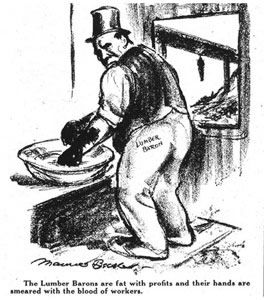
The spruce market plummeted after the war, but the lumber industry grew in other areas, particularly in pulp and paper production. Several pulp mills, which relied on cheap hemlock from the Olympic Peninsula, opened in the 1920s. These mills used new technologies to produce paper, particleboard, rayon, and other products made from wood pulp. The conversion to a peacetime economy and the development of new markets in Japan and on the Atlantic coast led to a boom in the early 1920s. While the new markets absorbed increased output, the expansion of the industry resurrected the problem of overproduction. Washington continued to produce over seven billion feet of lumber each year from 1924 to 1929 even though prices declined steadily after 1924.
The Great Depression dealt a terrible blow to an industry that was already struggling. Washington's lumber production dropped from 7.3 billion board feet in 1929 to 2.2 billion board feet in 1932, the smallest amount since 1904. By 1933 over half of the loggers normally employed in camps and mills were out of work, while those who kept their jobs had reduced wages and hours. Shortly after he took office in 1933, President Franklin Roosevelt persuaded Congress to create the National Recovery Administration (NRA) to combat the Depression. The legislation that created the NRA guaranteed workers' right to organize and bargain with management through their own representatives. Unions affiliated with the American Federation of Labor (AFL) gained strength during the 1930s, and AFL timber locals in 1935 formed the Northwest Council of Sawmill and Timber Workers. The AFL focused on organizing skilled workers, while the Committee for Industrial Organization (CIO), founded by John L. Lewis in 1935, advocated industry-wide unionization of both skilled and unskilled workers. The CIO also became influential during the Depression, especially after the International Woodworkers of America become an affiliate of the CIO in 1937. Labor was quite successful at pressing its demands at this time; after a series of strikes, several AFL and CIO unions won recognition from management. These unions helped to increase the average hourly wage in Washington sawmills by over 20 percent between 1935 and 1938.
The NRA also enacted a system of industrial self-government, allowing industries to develop codes to govern fair competition, production, prices, and conservation measures. Lumbermen drafted and approved a code for their industry in 1933. Upon President Roosevelt's request, lumbermen included a clause that required them "to carry out such practicable measures as may be necessary . . . in respect of conservation and sustained production of forest resources." The adoption of the lumber code coincided with the introduction of the caterpillar tractor and selective logging. Caterpillar tractors made it possible to select only the best quality timber, leaving the remaining trees for future use (see document 42). Lumbermen rejected selective logging, arguing that the Depression prevented them from buying new equipment. Still, their lumber code expressed a commitment to selective logging and sustained yield, although the resolution was not binding. Lumber firms worried that Roosevelt would use the code to impose conservation policies that would harm their business.
By early 1934 most lumbermen believed that the code needed drastic revisions. They complained about unfair treatment on conservation issues, arguing that the Forest Service was not doing its part to spend funds for fire protection and research. Large manufacturers, moreover, accused small operators of violating the production and price controls set forth in the code, and small companies complained that the code favored large corporations. The Supreme Court declared the NRA unconstitutional in 1935, and the lumber code was dismantled, much to many lumber operators' relief. Many large and small lumbermen concluded that industrial self-government could not work because the industry was too large and diverse. It was next to impossible to develop a single point of view on any issue.
Although the collapse of the NRA did away with the lumber code and its conservation clause, the lumber industry still faced growing opposition from people who wanted to preserve some forests from harvesting. This battle between preservationists and timber interests was exemplified by the campaign to create Olympic National Park. Preservation groups wanted to create a large park by combining the existing national monument with adjacent national forest lands (see document 31). The ensuing controversy focused on the boundaries of the proposed park. Because logging was prohibited in national parks, the lumber industry feared that it would lose access to the Olympics' vast stands of hemlock, which it needed for pulp and paper manufacturing. The Forest Service and local mill owners argued that including the hemlock stands in the park would ruin the local economy. They wanted to create a much smaller park would contain very little merchantable timber (see document 32 and document 33). Though the Forest Service sided with the timber industry, the National Park Service supported preservationists' call for a large park. In 1937 President Roosevelt took a trip to the Olympics in order to resolve the dispute. Alarmed by the extensive areas of logged land that he saw, he came out in favor of a large park. In 1938 Roosevelt convinced Congress to establish a 648,000-acre Olympic National Park, and in 1940 he added another 187,000 acres to the park.
The creation of a large park was a victory for preservationists over the powerful lumber interests, but it also demonstrated the fierce conflict that had developed between the two groups. Even after the establishment of the park, the lumber industry continued to advocate reducing the size of the park and allowing logging inside its boundaries (see document 48). Washington's forests were a precious commodity to conservationists, preservationists, and the lumber industry, and, in the decades that followed, these groups continued to fight about the proper use of the forests.
E. Intensive Logging, Environmentalism, and Owls: Washington's Forests after 1940
During and after World War II, the lumber industry lost its dominant position in Washington's economy. The industry did not really recover from the effects of the Great Depression until after the war ended in 1945. The postwar housing boom led Washington lumber companies to increase their harvests from 3.3 billion board feet in 1944 to 5 billion board feet in 1951. Though logging remained heavy for the next three decades, the industry never again reached the peak harvest levels of the late 1920s, when it cut 7 billion board feet per year. Many of the trees cut in Washington after the Second World War went to pulp mills because the demand for pulp and paper products was strong. Indeed, by 1960 the value of the state's pulp and paper manufacturing was greater than the value of its lumber production. But paper and lumber were hardly the only industries that thrived during the period of postwar prosperity. Washington's economy diversified during the 1940s and 1950s, when the state began producing substantial quantities of airplanes, aluminum, atomic weapons, cherries, financial services, and a host of other goods. In sum, even though the timber industry was growing, other parts of the economy were growing much more rapidly. As the lumber industry lost its status as the state's largest employer, its political power consequently declined.
The postwar era also marked the end of a relatively cheap supply of timber. Years of logging had steadily reduced the amount of mature timber on private lands. As the supply of private timber diminished, its value increased rapidly. Because forestlands were becoming so expensive, lumber companies became more interested in conservation measures that would guarantee their future timber supplies. During World War II the West Coast Lumbermen's Association and the South Olympic Tree Farm Company organized timber farms and began focusing on reforestation. Other groups followed suit.
With private supplies of trees in decline, lumber companies became more dependent on Washington's national forests Throughout the 1940s and 1950s, logging firms clamored for access to more national forest lands, and the Forest Service was happy to give it to them. Ever since the time of Gifford Pinchot, Forest Service officials had wanted to cut down their old-growth forests and replace them with managed forests. But the flood of new timber sales and the pressure on Forest Service managers to accommodate the demand for trees was unlike anything the agency had experienced in the prewar years. The postwar period ushered in a new era of national forest administration, one that emphasized rapid logging and intensive management. The Forest Service became overly optimistic about the amount of timber production that the national forests could sustain. Even though a 1969 study warned that the old-growth forests of Washington and Oregon were being cut at a rate that could soon cause a 30 percent decline in timber harvests, Forest Service managers believed that technology and scientific expertise could circumvent depletion and make the forests more productive. The Forest Service was supposed to ensure the integrity and sustainability of the national forests, but its postwar policies maximized timber harvests, undermining its efforts to implement sustained-yield forestry and environmental protection.
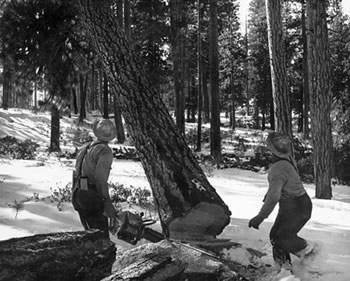
New technologies facilitated the rapid harvest of the forests. Most logging companies had begun using gasoline-powered chainsaws by the start of World War II. This piece of equipment greatly reduced the amount of labor and time required to cut down a tree, making large logging crews obsolete (see document 43). One faller with a chainsaw could do the work of 15 fallers with axes and crosscut saws. Moreover, by the early 1960s, log trucks had replaced logging railroads in removing timber from the deep woods (see document 44). Because log trucks could haul loads of more than 100 tons, they precipitated the construction of an extensive network of logging roads into the national forests and private holdings. The Forest Service had become the nation's most active
road builder by the 1970s.
In the 1970s the forest-products industry in Washington faced problems with slowdowns in housing construction, depleted timber supplies, and
competition from other lumber sources in British Columbia and the American South. Still, logging in the national forests of Washington and Oregon continued at a rapid pace. During the 1960s and 1970s, forest management plans continually increased the annual allowable cut, and in some forests, managers allowed harvests to exceed the allowable cut. The plans assumed only slight losses in soil productivity due to erosion and overestimated how much science and technology could increase harvests. As a result, timber harvests on federal lands reached an all-time high in 1987.
As the Forest Service continued its intensive management of the national forests, the environmental movement gained power. Before the Second World War, only a very small percentage of Americans were preservationists. But as incomes increased and people had more leisure time, the popularity of hiking, camping, fishing, and other types of outdoor recreation skyrocketed after 1945. More Americans became interested in preserving forests for recreational purposes. In addition, many of the people who moved to Washington after the war had been attracted by the state's environment—its mountains, beaches, and forests. The heavy logging of national forests in the postwar period therefore alarmed many Washingtonians. Preservationist groups such as the Audubon Society and the Sierra Club were able to recruit thousands of new members (see document 51). By the mid-1960s it became clear that the proliferation and growth of organizations devoted to preserving wilderness and reducing pollution demonstrated the emergence of a powerful environmental movement.
Environmentalists fought several battles to preserve more of Washington's forests. After a long campaign, environmental groups successfully pushed the Wilderness Act through Congress in 1964. This bill allowed for some federal lands to receive a wilderness designation that prohibited all forms of development except the construction of hiking trails. Concerned about logging, environmentalists also led a successful drive to create the 1.3 million-acre North Cascades National Park Complex in 1968 (see document 49 and document 50). In addition to a 685,000-acre national park, which is managed as wilderness, the complex includes the Lake Chelan and Ross Lake National Recreation Areas, which permit tourist development but not commercial logging.
The passage of the Endangered Species Act (ESA) in 1973 was another environmentalist victory. The law required the U.S. Fish and Wildlife Service to identify threatened plants and animals, and it required federal agencies to take actions to promote the recovery of these species. The ESA recognized that all species were members of ecosystems and worthy of some protection. Its passage indicated a growing interest in biodiversity and ecosystem science. During the postwar years, scientists and environmentalists also developed an appreciation of old-growth forests as biological treasures. Though Gifford Pinchot and other foresters had derided old-growth forests as unproductive, scientists discovered that these forests were actually dynamic, complex ecosystems that served as habitat for thousands of species of microorganisms, fungi, insects, plants, and animals. Old-growth advocates argued that managed forests—composed primarily of recent clear-cuts and even-aged, single-species stands of timber—lacked this diversity.
The passage of the ESA and the increasing interest in ecology set the stage for a heated battle over the forests of the Pacific Northwest. In 1990 the Fish and Wildlife Service declared the northern spotted owl, which lives in the old-growth forests of Washington, Oregon, and northern California, a threatened species. In March 1991 United States District Court Judge William Dwyer issued an injunction to halt state and federal timber sales until further studies on the owl's habitat were completed; Dwyer also restricted logging on most national forests and many private timberlands in the region. After a court order, the Fish and Wildlife Service designated 11.6 million acres outside parks as critical habitat for the owl because many scientists argued that the species needed large areas of old growth in order to survive. William Dietrich, a reporter for the Seattle Times, noted that the spotted owl thus acted as a "surrogate for old-growth protection." There were no laws that protected endangered ecosystems, so environmentalists and concerned scientists used the endangered status of the owl as a way to preserve the last major stands of old growth in the national forests.
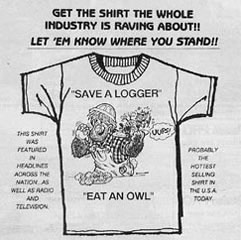
For those who lived and worked in logging communities, the protection of the spotted owl threatened their livelihood and way of life. By 1990 approximately 65 percent of the Olympic National Forest had been set aside for owl habitat, and the Forest Service announced that it was selling virtually no timber in that forest. Coupled with the recession of the 1990s and rising log exports to Japan, restrictions on logging resulted in mill closures; in 1990 alone, more than 50 mills closed in the Pacific Northwest. As mills closed, thousands of people were laid off. Though the problems facing the timber industry were multifaceted, environmentalists and spotted owls made convenient scapegoats for the industry's woes (see document 53 and document 54). Residents of lumber communities staged rallies in both Seattle and Olympia in May 1991 to express their growing outrage and their opposition to owl-protection measures.
Instead of blaming the spotted owl, many individuals dependent on the lumber industry began to explore other ways to sustain themselves and their communities. One Forks couple shut down their logging business and began to lead school children on science and nature trips. Darrington city planners began to promote tourism, instituting weekend crafts markets and festivals and encouraging the construction of new parks, restaurants, and inns. Aberdeen, Forks, and other towns in western Washington started programs for loggers to retrain them for new careers and to help them get their high school diplomas. Unfortunately, the jobs created by tourism and other economic development efforts generally paid less much less than logging or millwork. In addition, the number of new jobs did not even approach the number of jobs lost. Unemployment rates remained very high in timber-dependent communities throughout the 1990s, and many families had to move elsewhere to find work.
As the spotted owl and old-growth controversy intensified, President Clinton organized the Northwest Forest Summit in April 1993 in the hopes of resolving the issue. Along with Vice President Al Gore and four Cabinet members, scientists and representatives from environmental organizations, timber communities, and lumber mills gathered in Portland for a discussion of the future of the Northwest's old-growth forests (see document 52). Clinton unveiled his forest policy three months after the summit. His plan included an annual harvest of 1.2 billion board feet of timber in the national forests of western Washington, western Oregon, and northern California; the establishment of old-growth reserves and conservation areas to protect threatened species; some salvage logging and thinning; and funds to aid lumber workers and timber-dependent towns with job retraining and economic development (see document 55). Loggers complained that 1.2 billion board feet was too little—it was about one quarter of the harvest levels in the late 1980s. Environmentalists, on the other hand, claimed that 1.2 billion board feet was too much and that salvage logging and thinning opened the door for destructive logging. The White House later revised the plan by scaling back annual timber harvests to 1.1 billion board feet, setting aside more land for reserves to protect owl habitat, widening the no-logging buffer zones along streams from 50 to 100 feet, and slightly increasing the economic aid for timber-dependent communities. In June 1994 Judge Dwyer lifted his ban on most logging in the national forests, and in December he upheld Clinton's Northwest Forest Plan. Though they did not get everything they wanted, environmentalists still considered the adoption of the new forest policy to be a substantial victory.
The Northwest Forest Plan marked an important policy shift, but it did not end the struggles over the region's forests. Several Pacific Northwest runs of cutthroat trout and coho, sockeye, and chinook salmon were listed as endangered under the Endangered Species Act in 1998. These listings have brought more restrictions to logging activities and imposed penalties if salmon streams are damaged. After further reductions in logging levels in 1999, the timber industry has claimed that the Northwest Forest Plan has failed to provide a steady, reliable supply of wood for the region's mills. President George W. Bush's recent efforts to increase commercial thinning and salvage logging as a way to reduce forest fires have initiated another round of debate and conflict.
The recent controversies surrounding Washington State's forests are a reflection of this natural resource's long, complex history. Since the 18th century, the Pacific Northwest has been associated with vast forests and the lumber industry. Washingtonians have coveted the state's forests, but they have valued them for widely different reasons. The beliefs and actions of people in the past have shaped the forests we have today. Native peoples used fire, and other groups have employed axes, donkey engines, railroads, tractors, chainsaws, and logging roads—as well as publicity, presidential proclamations, soldiers, labor unions, lawsuits, and wilderness-protection rules—to change the forests. In turn, the forests have shaped the economy of the state and the identities of its residents. However the forests may change in later years, it seems to safe to say that they will continue to play a key role in the future of the Evergreen State.
| Section I | Section III | Section IV | Section V | Section VI |